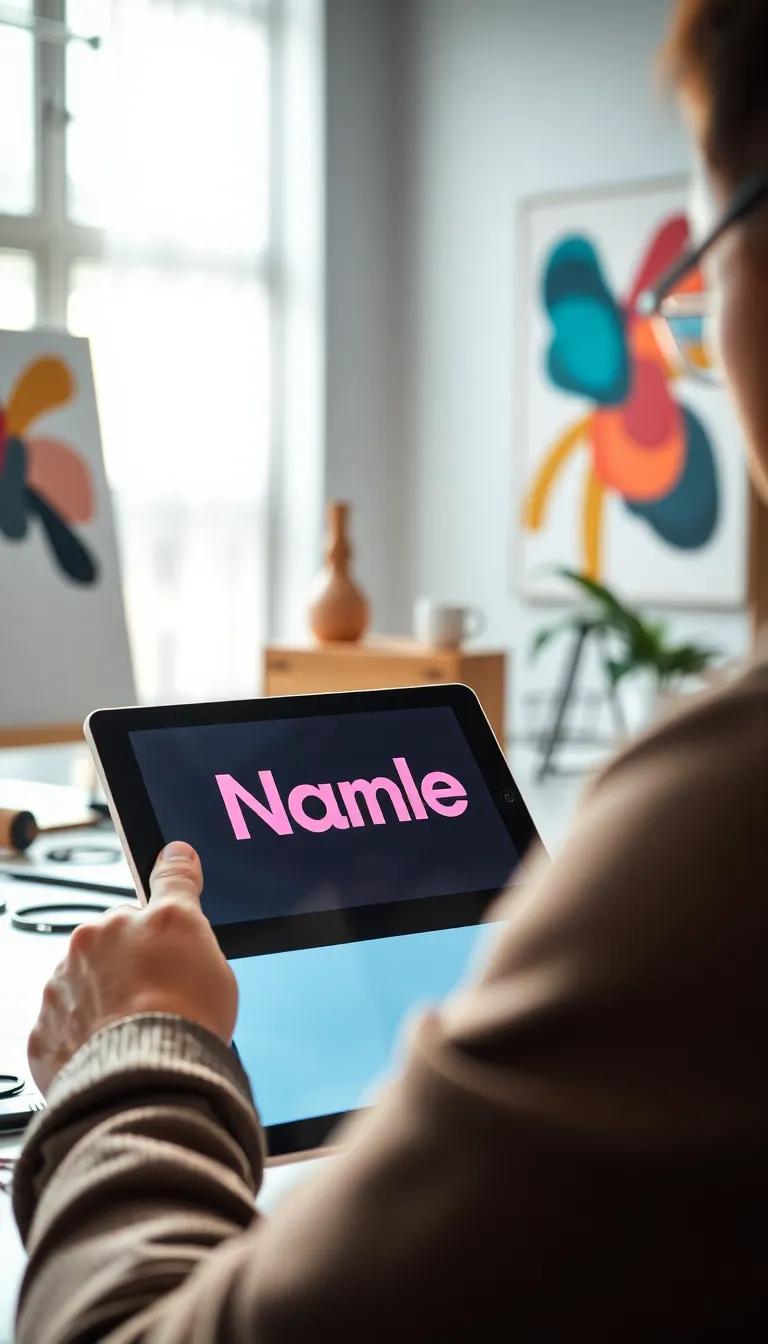Introduction
A logo serves as the visual identity of a company or brand, encapsulating its essence in a single graphic mark or emblem. The design of a name logo is crucial as it represents the company’s brand ethos, resonates with its target audience, and differentiates it from competitors. This guide explores the comprehensive process of crafting a memorable name logo, from the initial brainstorming phase to the final design. We will delve into essential design principles, color theory, typography, and the significance of adaptability in various media.
Moving beyond basic design elements, it is important to understand the historical context and technological advancements that have shaped modern logo design. The evolution of logos reflects broader shifts in societal values and consumer behavior. As such, creating a name logo requires not only creativity but also a strategic approach that considers both current trends and timeless principles. This article aims to provide aspiring designers and business owners with the tools they need to create an impactful name logo that stands the test of time.
Understanding the Significance of a Name Logo
A name logo holds a pivotal role in branding, acting as the face of a business or organization. Unlike purely graphic logos, which rely on symbols and images, a name logo emphasizes the typographical representation of the brand itself. This unique focus allows it to establish a distinct identity, making it immediately recognizable and memorable to consumers. By encapsulating the essence of the brand within its name, a well-crafted name logo becomes a vital component of a company’s overall marketing strategy.
The significance of a name logo extends beyond mere aesthetics; it communicates the brand’s values and mission. A thoughtfully designed name logo conveys essential characteristics such as professionalism, creativity, or friendliness, thereby establishing an emotional connection with the target audience. For instance, a creative font might suggest an innovative approach, while a bold typeface can evoke strength and reliability. This visual representation is crucial for brand positioning and differentiation in a crowded marketplace.
Name logos serve as reliable tools for driving brand recognition. They act as a consistent visual cue that consumers associate with specific products, services, and experiences. Consistency in branding, facilitated by a strong name logo, nurtures brand loyalty among consumers who come to expect a certain quality and aesthetic aligned with that name. The repetition of this logo across various marketing channels enhances its recall, embedding the brand deeper into the consumer’s memory.
In digital marketing, a strong name logo enhances social media presence, website recognition, and promotional materials. The effectiveness of a name logo can significantly influence click-through rates and customer engagement metrics. As such, businesses should prioritize the design and integration of their name logo into every aspect of their branding strategy, ensuring that it aligns with their overarching brand identity and messaging goals.
The Elements of Effective Logo Design Understanding Key Components in Name Logos
Shape, Color, Typography, and Space in Logo Design
The design of a name logo is a crucial aspect of branding that leverages various fundamental elements to establish a memorable identity. Each component—shape, color, typography, and space—plays a unique role in how the logo is perceived and how effectively it communicates the brand’s message.
Shapes serve as the foundation of any logo design, evoking certain emotions and associations. For instance, circles often signify unity and harmony, while sharp angles might convey stability and strength. When crafting a name logo, consider how the shape of the text interacts with the overall emblem. A rounded typeface can create a sense of friendliness, whereas jagged fonts may impart a feeling of edginess.
Color is another pivotal element that significantly influences brand perception. Different colors evoke varied emotional responses; for instance, blue typically relates to trust and professionalism, while red may invoke passion and energy. When selecting colors for a name logo, mindfulness of cultural connotations and target audience preferences is essential. A well-chosen color palette not only helps the logo stand out but also deepens the emotional connection with the audience.
Finally, space—both positive and negative—plays a critical role in logo design. Thoughtful use of space can lead to a balanced and harmonious logo. Sufficient white space allows for clarity and prevents the design from appearing cluttered, enhancing its memorability. When designing a name logo, consider how each element interacts within the space to create visual appeal and impact.
Mastering these key elements—shape, color, typography, and space—is vital for crafting effective name logos. When harmonized, they can create a cohesive and engaging logo that resonates with audiences, fostering brand recognition and loyalty as businesses look to innovate and grow in an increasingly competitive landscape.
Research and Brainstorming for Logo Ideas Informing Your Design Through InDepth Investigation
Understanding the Landscape: Competitor Analysis
Effective logo design begins long before the first sketch is created; it starts with extensive research. One of the primary aspects of this phase involves competitor analysis. By examining the logos of similar businesses within your industry, you can identify trends and common practices that set the tone for the marketplace. Look for patterns in color schemes, typography, and shapes. Are there specific themes that resonate with your audience? If so, how can you adapt these elements to set your logo apart while still aligning with expectations?
As you scrutinize your competitors, take notice of what works and what falls flat. This analysis not only reveals gaps in the market but also helps in understanding the visual language your audience has grown accustomed to. It is crucial, however, to ensure that your logo does not merely replicate what is already available; the goal is to create a distinctive identity that stands out amidst the noise.
Gaining Insights: Audience Understanding
Equally vital to your logo design process is a comprehensive understanding of your target audience. Who are they? What are their preferences, interests, and pain points? Conduct surveys, focus groups, or social media polls to gather insights directly from potential customers. This information will inform not only the aesthetics of your logo but also its ability to communicate the brand’s values effectively.
Brainstorm ideas based on the gathered information. Begin to sketch or write down concepts that combine elements derived from your research. Encourage creative thinking by conducting team brainstorming sessions where all ideas are welcome, no matter how outlandish they may seem. This collaborative environment can result in unique ideas that might otherwise remain undiscovered, paving the way for a name logo that truly captures the essence of your brand. In this stage of development, the combination of thorough research and creative brainstorming will guide you toward crafting a memorable and impactful logo.
Creating a Unique Design Concept Crafting a Name Logo that Stands Out
Understanding the Brand Essence
To establish a distinctive name logo, it is imperative to possess a deep understanding of the brand’s essence. This encompasses the brand’s mission, vision, values, and target audience. By encapsulating these elements, one can create a logo that is not merely a visual symbol but a representation of what the brand stands for. Engaging with stakeholders and conducting interviews can yield valuable insights into the emotional triggers that resonate with audiences. This feedback is invaluable for shaping a logo that aligns closely with consumer expectations and desires.
Competitive Analysis and Market Differentiation
In a crowded market, differentiation is key. It’s beneficial to perform a comprehensive analysis of competitor logos. Identify common themes, colors, and design elements that can either be adopted or deliberately avoided. This form of analysis not only highlights what works but also uncovers areas where innovation can thrive. Aim to make your design distinctive by choosing unique color combinations, typography, and layout styles that are seldom seen in your industry. The goal is to create a visual identity that stands apart, allowing consumers to effortlessly recognize and remember the brand.
Conceptualizing the Logo Design
Once the foundational elements are established, it’s time to brainstorm design concepts. Sketch multiple variations based on the research and insights gathered. Exploring diverse interpretations can lead to unexpected design solutions that are both eye-catching and relevant. Consider how different shapes and symbols can be metaphorically related to the brand’s values or mission. For instance, curvy lines might evoke a feeling of friendliness and approachability, while angular shapes might convey strength and stability.
During this phase, digital tools can play a pivotal role by allowing designers to visualize their concepts in real-time. Creating initial drafts using software can facilitate easy modifications and explorations of various iterations. Feedback loops with stakeholders can refine these designs, ensuring they resonate effectively with the intended audience.
A successful name logo will encapsulate the essence of the brand while standing out in a saturated market. By thoughtfully considering the elements discussed, one can forge a logo that not only attracts attention but also fosters brand loyalty and recognition over time.
The Role of Digital Tools in Logo Design
Leveraging Software for Memorable Name Logos
The creation of an impactful name logo is significantly influenced by the digital tools available today. Software dedicated to graphic design offers a spectrum of functionalities that can transform simple ideas into powerful visual representations. Programs like Adobe Illustrator, CorelDRAW, and Sketch stand at the forefront, providing designers with precise control over every aspect of the logo creation process.
Adobe Illustrator is perhaps the most popular choice among professionals. Its vector graphics capabilities allow designers to create scalable logos that maintain their quality across various sizes and platforms. The precision of Illustrator enables intricate detailing, which is crucial in making a logo not just visually appealing but also memorable. With an extensive library of fonts and design elements, it allows for the seamless integration of typography with graphic motifs, crucial for crafting name logos that resonate with brand identity.
CorelDRAW offers a similar suite of tools, with user-friendly features that make it accessible for beginners. Its intuitive interface allows users to design logos quickly, enabling experimentation with different styles and typesetting. The power of CorelDRAW lies in its versatility; users can personalize their workspace and utilize templates to streamline the design process, ensuring efficiency without sacrificing creativity.
In addition to these powerful design tools, platforms like Canva have emerged, catering to those who may not possess extensive design skills. Canva’s simplicity makes it an ideal choice for small businesses and entrepreneurs looking to create logos quickly. The drag-and-drop functionality, coupled with an array of pre-designed templates, empowers anyone to craft a unique logo that can stand out in a crowded marketplace.
Advantages of Digital Tools in Logo Creation
The advantages offered by these digital tools are manifold. First and foremost is the speed of production; designers can iterate quickly, testing out multiple concepts without the need for extensive reworking. This rapid prototyping is vital in the design process, facilitating real-time feedback and adjustments.
Another significant benefit is the collaborative nature of many of these platforms. Modern design software often allows for easy sharing and collaboration, enabling teams to work together effectively, regardless of geographical location. This capability enhances creativity, as diverse perspectives can contribute to refining the name logo design.
Incorporating digital tools into the logo design process not only streamlines creativity but also ensures that the final product resonates with the brand’s vision and is versatile enough for various applications, a crucial step before active testing across different media.
Testing Your Logo Across Different Media
The Importance of Versatile Logo Design
Once you have created a logo that resonates with your brand identity, the next critical step is to test its application across various media. The versatility and effectiveness of a logo can greatly influence brand recognition, ensuring that it remains impactful whether displayed on a digital platform or printed material.
Logos will encounter a wide range of sizes, resolutions, and backgrounds, from large billboards to small business cards and social media icons. Each of these formats poses unique challenges. A logo that looks crisp and appealing on a website may not maintain the same visual integrity when printed on fabric or displayed on a mobile app. Therefore, evaluating your logo in multiple contexts will help identify potential issues before it’s officially launched.
Strategies for Testing Your Logo
To effectively test your logo, consider implementing the following strategies:
- Scale Tests: Evaluate how your logo appears in various sizes. It should maintain clarity and legibility when scaled down for smaller screens while remaining impactful at larger sizes.
- Color Variations: Assess how your logo’s color palette looks on different backgrounds. It must be adaptable to both light and dark settings without compromising its aesthetic appeal.
- Material Simulations: Print prototypes of your logo on various mediums such as paper, fabric, plastic, and metal. This will allow you to gauge how well it translates to physical products.
- Feedback Sessions: Collect feedback from potential customers and stakeholders. Ask them how the logo resonates within different contexts and what emotions it evokes.
Testing in different digital mediums—like websites, social media, and email signatures—can reveal design flaws that may not be obvious in a static setting. It is essential to retain a cohesive brand image across all platforms, ensuring that your logo reflects the same core elements, no matter where it is displayed.
A Comprehensive testing of your logo across various media not only solidifies its versatility and effectiveness but also paves the way for a successful launch. By addressing potential pitfalls early on, you fortify your brand against inconsistencies that could confuse or alienate your audience.
Finalizing and Launching Your Name Logo The Key Steps
Consolidating the Design Elements
As you reach the final stages of your name logo design, consolidating all the elements into a cohesive visual is paramount. Review the colors, typography, and any graphical elements that you have used. Ensure that each component aligns with your brand’s ethos and message. This is an opportunity to refine and enhance the logo, making minor adjustments that could significantly impact its effectiveness. Pay attention to the alignment, spacing, and overall balance. A well-structured logo not only looks professional but also makes it easier for consumers to recognize and remember it.
Gather feedback from your team or trusted peers who understand your brand. Utilize their perspectives to ensure that your logo resonates and captures the essence of what you are trying to convey. This step can lead to valuable insights, allowing you to make informed tweaks that elevate your design.
Preparing for Launch
Once your logo is polished and finalized, preparing for the launch involves more than just unveiling the design. It’s essential to develop a launch plan that includes context, storytelling, and engagement with your audience. Consider crafting a narrative about the design process, the values reflected in the logo, and your brand’s journey. This narrative can be shared through various platforms such as social media, press releases, and newsletters, giving your audience a deeper connection to the new visual identity.
Create a branding guideline document that outlines the proper use of the logo, including size, placement, and color variations. This guideline will serve as a reference point for anyone using your logo in future marketing materials, ensuring consistency across all channels.
Launching Your Logo on Multiple Platforms
When it’s time to launch, utilize all possible channels to maximize visibility. Share the new logo on your website, social media accounts, and email signatures. Utilize promotional materials, such as banners and stickers, to spread the word even further. Hosting a launch event, even if virtual, can create excitement and engage your audience directly. Encourage customers to share their thoughts on the new design and integrate their feedback into your ongoing branding strategy.
The launch of your name logo should not just be a standalone event but a pivotal point in your brand’s narrative—a chance to redefine your identity and reconnect with your audience. By following these steps, you can effectively finalize and launch your name logo, setting the stage for its success in the marketplace.
Conclusions
A well-crafted name logo is more than just an aesthetic element; it is a vital part of a brand’s identity. The insights presented in this guide illustrate the importance of thorough research, understanding design principles, and effective communication of the brand’s message. By mastering these elements, designers can create logos that not only capture attention but also convey the desired emotions and messages to the audience.
The goal of a name logo is to foster recognition and loyalty among consumers. By considering historical influences, adapting to technological developments, and remaining sensitive to cultural trends, one can ensure that a logo remains relevant and memorable. As you embark on your logo design journey, keep these principles in mind to craft a visual identity that leaves a lasting impression.





















